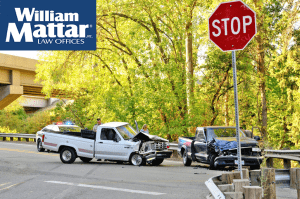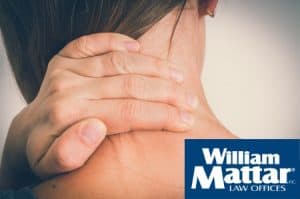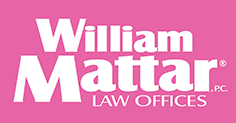T-Bone Accident Lawyer
 T-bone car accidents occur when one vehicle crashes into another at a right-angle, creating a “T” shape. Also sometimes referred to as a side-impact collision or broadside crash, T-bone car accidents usually include two vehicles and can be particularly dangerous. According to the National Highway Traffic Safety Administration’s most recent Traffic Safety Facts Annual Report, T-bone car accidents account for almost 20 percent of fatal collisions, leading all other types of collisions when it comes to vehicle deaths.
T-bone car accidents occur when one vehicle crashes into another at a right-angle, creating a “T” shape. Also sometimes referred to as a side-impact collision or broadside crash, T-bone car accidents usually include two vehicles and can be particularly dangerous. According to the National Highway Traffic Safety Administration’s most recent Traffic Safety Facts Annual Report, T-bone car accidents account for almost 20 percent of fatal collisions, leading all other types of collisions when it comes to vehicle deaths.
How Do Side-Impact Collisions Happen?
The majority of side-impact collisions occur at intersections when one car fails to yield the right of way. For example, a vehicle may pass through a red light or stop sign without looking and collide with the driver or passenger side of another vehicle.
T-bone car accidents are not limited to intersections. In fact, they can happen anywhere. One scenario might include a motorist pulling out of a driveway without being able to see an oncoming car.
A broadside car crash can be caused by negligent or reckless behavior. A vehicle could make a sudden lane change in front of another vehicle, resulting in a sudden impact. But several other factors beyond poor driving can also contribute to a potential side-impact collision.
Some of these factors may include:
- Defective car parts: A motor vehicle accident can be caused by malfunctioning parts. For instance, a driver may not be able to stop at an intersection because the brakes have failed. In this case, it may be more complicated to decide who is liable for the accident.
- Damaged roadways: Dangerous or poorly maintained roads can also lead to T-bone car accidents. Cars may swerve to avoid hitting a pothole or obstruction, resulting in the accidental collision with another car.
- Broken or missing traffic signals: T-bone crashes can also be caused by failing traffic infrastructure designed to protect drivers’ well being, such as malfunctioning traffic lights or missing stop signs.
Common Injuries Caused by T-Bone Accidents
 T-bone collisions are dangerous for several reasons. In a side-impact collision, the front of an oncoming vehicle connects with the side of another vehicle where there is little protection to the driver or passenger. Furthermore, most vehicles come with limited safety features. Assuming the vehicle is equipped with them, side airbags do not always afford sufficient protection against injury.
T-bone collisions are dangerous for several reasons. In a side-impact collision, the front of an oncoming vehicle connects with the side of another vehicle where there is little protection to the driver or passenger. Furthermore, most vehicles come with limited safety features. Assuming the vehicle is equipped with them, side airbags do not always afford sufficient protection against injury.
For these reasons, T-bone collisions can result in serious, life-changing injuries. The severity of the injuries may also be dependent on the speed and size of the oncoming vehicle. For example, a large SUV, truck, or transportation vehicle can pose a greater danger to motorists, especially motorcyclists, who are fully exposed.
Common injuries caused by T-bone car accidents may include, but are not limited to:
- Trauma to the head or neck, such as whiplash;
- Broken bones or amputation;
- Burns or lacerations to the face, head, or body;
- Penetrating injuries, such as punctured lungs or other internal organs; and
- Damage to the spinal cord.
Many of these injuries can lead to life-long physical and mental challenges, as well as devastating changes in a person’s quality of life. If you have suffered a serious injury from a broadside car accident, you may be entitled to compensation for your pain and suffering, loss of income, and medical costs.
How to Reduce the Risk of a T-Bone Collision
Even with all of the dangers on the road, there may be a way to reduce your risk of being involved in a T-bone car accident: follow the rules of the road. One important way to prevent a side-impact collision is to ensure that you observe the right of way at every intersection and come to a complete stop when appropriate. This means being aware of the other vehicles that may be turning or passing through the intersection.
Who is At Fault in a Broadside Crash?
Since broadside car crashes often involve two drivers, either driver may be liable for an accident. As mentioned, this is often the driver who failed to yield the right of way and collided with the other car.
However, certain cases may not be that simple. This is especially true if there is more than one vehicle involved in the car accident. In the case of a malfunctioning stoplight or dangerous road, an entity, rather than a person, may actually be liable for the car crash.
Hiring a personal injury lawyer is a great first step to determining who is at fault in a side-impact collision. A T-bone car accident lawyer can assist you in the legal process and even help you file a claim if you have been seriously injured.
Hurt In A Car? Call William Mattar.
Injuries sustained in a T-bone car accident may last for months or even years after the collision. At William Mattar Law Offices, our injury lawyers may be able to help after your accident. Call our car accident attorneys today at 844-444-4444.

















